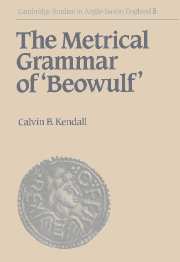Book contents
- Frontmatter
- Contents
- Preface
- List of abbreviations
- List of changes from Klaeber's text
- 1 The Beowulf-poet and his metrical grammar
- 2 The alliterative and metrical principles of Beowulf: Kuhn's ‘laws’ and the transformational rule
- 3 The three kinds of half-lines: extra-metrical alliteration and type A3
- 4 Displacement
- 5 Stressed proclitic adjectives: X-positions and the insertion rule
- 6 Problems with the identification of clause-non-initial half-lines: the proclitic onset
- 7 Half-lines with internal clause divisions: the transformational rule (revised)
- 8 The alliterative requirement of unstressed prefixes and the copulative conjunctions
- 9 The alliterative requirement of prepositions and the proclitic adverbs and instrumentals
- 10 The alliterative requirement of proclitic adjectives and pronouns: the alliterative rule of proclitics
- 11 Displaced and detached proclitics
- 12 The three classes of compounds: the alliterative requirement of class I compounds
- 13 The alliterative behaviour of class II compounds
- 14 The alliterative behaviour of class III compounds and simplexes
- 15 Metrical typology and the metrical grammar
- 16 Conclusions
- Appendix: A typology of the metre of Beowulf in relation to the metrical grammar
- Glossary of technical terms
- Bibliography
- Index of alliteration, scansion and metrical clause structure
- Index of verses specially discussed
1 - The Beowulf-poet and his metrical grammar
Published online by Cambridge University Press: 22 September 2009
- Frontmatter
- Contents
- Preface
- List of abbreviations
- List of changes from Klaeber's text
- 1 The Beowulf-poet and his metrical grammar
- 2 The alliterative and metrical principles of Beowulf: Kuhn's ‘laws’ and the transformational rule
- 3 The three kinds of half-lines: extra-metrical alliteration and type A3
- 4 Displacement
- 5 Stressed proclitic adjectives: X-positions and the insertion rule
- 6 Problems with the identification of clause-non-initial half-lines: the proclitic onset
- 7 Half-lines with internal clause divisions: the transformational rule (revised)
- 8 The alliterative requirement of unstressed prefixes and the copulative conjunctions
- 9 The alliterative requirement of prepositions and the proclitic adverbs and instrumentals
- 10 The alliterative requirement of proclitic adjectives and pronouns: the alliterative rule of proclitics
- 11 Displaced and detached proclitics
- 12 The three classes of compounds: the alliterative requirement of class I compounds
- 13 The alliterative behaviour of class II compounds
- 14 The alliterative behaviour of class III compounds and simplexes
- 15 Metrical typology and the metrical grammar
- 16 Conclusions
- Appendix: A typology of the metre of Beowulf in relation to the metrical grammar
- Glossary of technical terms
- Bibliography
- Index of alliteration, scansion and metrical clause structure
- Index of verses specially discussed
Summary
Beowulf is a poem of infinite variety. If we cannot know precisely what it may have meant to its original, probably monastic, audience, it certainly speaks to modern audiences in many modes and moods. It has been called a heroic epic, a wondertale, an elegy for a bygone age, a mirror for princes, a celebration of pagan Germanic values, an allegory of Christian virtues, an exploration of the moral ambiguities of life and so on.
The style and structure of the poem are as rich and complex as the matter which they embody. So intertwined and mutually reinforcing are content, style and structure that J. R. R. Tolkien compared the shape of its narrative to the form of the alliterative long line, and John Leyerle pointed out the resemblance of its structure to the intricate interlace designs of the Anglo-Saxon art of the seventh and eighth centuries.
The Beowulf-poet was fascinated by the ways and means of oral composition. He incorporated several narratives of storytelling into his own narrative. Hrothgar builds the great hall Heorot, and his scop sings a song of creation, the substance of which the poet summarizes (90b–98). This recitation is part of the joyful noise of celebration which angers Grendel and incites his attack on the hall. When Beowulf arrives at Heorot, bringing an offer of help against Grendel, the Danes celebrate again, and the scop from time to time sings with his clear voice (496b–97a).
- Type
- Chapter
- Information
- The Metrical Grammar of Beowulf , pp. 1 - 12Publisher: Cambridge University PressPrint publication year: 1991



